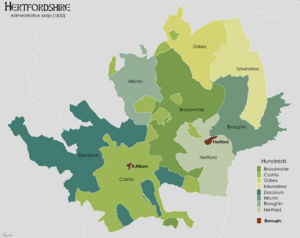Liberty of St Albans facts for kids
The Liberty of St Albans was a special area in Hertfordshire, England. Even though it was inside Hertfordshire, it acted like its own independent county for many years! It was also known as the Hundred of Albanestou or Cashio.
This unique area was first connected to the famous abbey of St Albans. Later, it was linked to the local town council, called the borough corporation. The Liberty of St Albans finally became a full part of Hertfordshire in 1874.
Contents
What Was the Liberty of St Albans?
The exact start of the Liberty of St Albans isn't fully clear. However, the abbots (leaders) of St Albans Abbey said that its special rights were first given by King Offa of Mercia. King Offa founded the abbey way back in 793.
The Liberty seems to have been created from parts of two church areas: the Diocese of London and the Diocese of Lincoln.
Early History and Growth
When the Domesday Book was written (a big survey of England in 1086), this area was known as Albanestou. Over time, the Liberty's borders grew bigger. At some points, it even included parts of Buckinghamshire.
We don't know exactly what powers the Liberty had before the 1100s. But later, King Edward I gave the abbot of St Albans very special powers. These were called palatine powers, which meant the abbot had authority almost like a king in that area. This was similar to the powers held by the bishops of Durham and Ely.
Changes After the Abbey
The St Albans Abbey was later closed down during a time called the Dissolution of the Monasteries. After this, the Borough of St Albans was given a special document called a charter. This made it a "free borough," meaning it was no longer controlled by the abbot.
From then on, the Liberty was managed by the borough's corporation (its local government). The special palatine status ended, but the borough and Liberty still had their own quarter sessions. Quarter sessions were local courts that met four times a year to deal with legal cases. The administration was led by a high steward, chosen by the corporation.
Becoming Part of Hertfordshire
The Liberty of St Albans officially joined the county of Hertfordshire in 1874. This happened because of a special law passed by Parliament. This law divided Hertfordshire into two main parts:
- The eastern part became the Hertford division.
- The western part became known as the Liberty of St Albans Division.
Even though they were now part of one county, these two divisions still had separate quarter sessions. However, they shared a single "commission of the peace," which meant they had the same group of local judges (justices of the peace). The 1874 law made it very clear that even though it was called the "St Albans division," it was no longer to be considered a separate liberty in the future.
In 1889, another important law, the Local Government Act 1888, created an elected county council for Hertfordshire. This council covered both the Hertford and St Albans divisions. For some time after this, the county's administration was split between the towns of Hertford and St Albans.
Parishes of the Liberty
By the 1800s, the Liberty of St Albans included all or parts of these local areas, called parishes:
- Abbots Langley
- Aldenham
- Bramfield
- Chipping Barnet
- Codicote
- East Barnet
- Elstree
- Hexton
- Newnham
- Northaw
- Norton
- Redbourn
- Rickmansworth
- Ridge
- St Albans (part of this was inside the borough of St Albans)
- St Michael (partly inside the borough of St Albans)
- St Paul's Walden
- St Peter (partly inside the borough of St Albans)
- St Stephen (partly inside the borough of St Albans from 1835)
- Sandridge (partly inside the borough of St Albans from 1887)
- Sarratt
- Shephall
- South Mimms
- Watford


